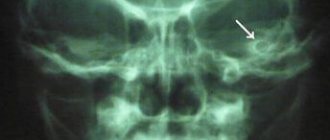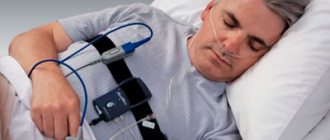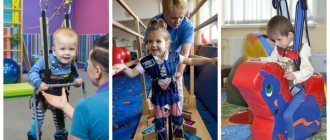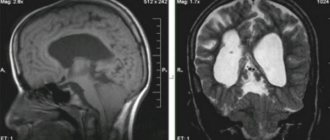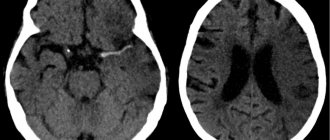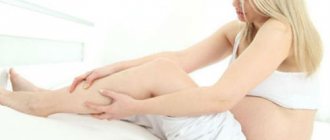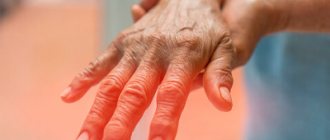Neurology Symptoms Services and prices Specialists Diseases
Fainting (syncope) is a pathological condition with loss of consciousness associated with difficulty in blood supply to brain tissue. Its period is no more than 30 seconds, then the person comes to his senses on his own or with the help of medications.
Characteristic
Normally, the central nervous system is well supplied with blood to supply vitamins, trace elements, minerals and oxygen. If their level drops sharply, fainting occurs. Neurologists call it transient cerebral hypoxia. Causes of circulatory obstruction:
- decreased cardiac muscle function with decreased output;
- pathologies of rhythm and heart rate;
- decrease in vascular endothelial tone.
In addition to fainting, vascular insufficiency is caused by other pathologies:
- collapse – a sharp drop in blood pressure with danger to internal organs and the patient’s life;
- cardiogenic shock - insufficiency of left ventricular function with difficulty in blood flow.
Causes of fainting
Cardiovascular diseases
Syncope associated with cardiac output obstruction
- aortic stenosis
- mitral stenosis
- hypertrophic cardiomyopathy
Syncope associated with cardiac arrhythmia
Dysregulation of vascular tone and blood volume
- reflex syncope - neurocardiogenic (vasovagal) syncope
- carotid sinus hypersensitivity
- situational syncope (coughing, sneezing, swallowing, urination, defecation, orthostatic instability syndromes)
Primary causes of autonomic failure:
- True autonomic failure
- Multiple system atrophy
- Postural otostatic tachycardia syndrome
- Acute autonomic failure
Secondary causes of autonomic dysfunction
- additional causes of orthostatic instability
Other causes of fainting
- Hypoglycemia
- hyperventilation
Subclavian steal syndrome
- decrease in circulating blood volume
- Carcinoid
- medications
Multifactorial syncope (more common in older patients)
The basis of the clinical diagnosis of syncope is a carefully collected history, which is sometimes absent due to the presence of retrograde amnesia in the patient, especially in elderly patients.
Classification subtypes of syndromes
The classification of syncope is very complex.
They are distinguished according to pathophysiological principles. It should be noted that in a significant number of cases the cause of syncope cannot be determined. In this case, they speak of idiopathic syncope syndrome. The following types of syncope also differ:
- Reflex . These include vasovagal and situational fainting.
- Orthostatic . They arise due to insufficient autonomic regulation, taking certain medications, drinking alcoholic beverages, and hypovolemia.
- Cardiogenic . The cause of syncope in this case is cardiovascular pathology.
- Cerebrovascular . Occurs due to blockage of the subclavian vein by a thrombus.
There are also non-syncope pathologies, but they are diagnosed as syncope. Complete or partial loss of consciousness during a fall occurs due to hypoglycemia, epilepsy, poisoning, and ischemic attacks.
There are non-syncope states without loss of consciousness. These include short-term muscle relaxation due to emotional overload, panic attack, pseudosyncope of a psychogenic nature, as well as hysterical syndromes.
A patient with syncope should be asked the following questions:
- At what age did you first faint, and how often do you faint?
- How long did it take from the moment you realized that “something was wrong” with you until you lost consciousness? This is a key question that will allow us to assess the course of the prodromal period.
- What were you doing when the symptoms appeared? What position were you in: lying, sitting, standing, in motion?
- What sensations did you experience before losing consciousness - nausea, fullness in the stomach, increased salivation, sweating, flushing, feeling hot or cold, sudden yawning, tingling or numbness in the arms and legs, flashing “floaters” before the eyes or distorted perception, spots before the eyes ?
- Did you feel any smells, sounds, or visual distortions before you lost consciousness? Were you injured during the fall?
- Did you feel dizzy, nauseous during injections or taking blood for analysis?
- Do you get motion sickness in transport?
- Did you understand what happened to you when you woke up?
- During fainting, did you bite your tongue or cheek, did you feel weakness in half of your body after waking up, did you experience urinary or fecal incontinence during the attack?
It is also important to ask questions to the witness of the syncope, especially when seeing an elderly patient with retrograde amnesia, such as:
- What did the patient complain about before he lost consciousness?
- How long was the patient unconscious?
- Did you have any convulsions while you were unconscious?
- did the patient make involuntary sounds during loss of consciousness?
- did the patient wet himself or lose stool?
- Was the patient tense or, conversely, lethargic at the time of loss of consciousness?
- did the patient look deathly pale, with a gray or sallow complexion?
- Did you quickly realize what happened after waking up, or was you disoriented and paralyzed?
These features of the anamnesis, obtained from the patient and from the witness, make it possible to most accurately identify the cause of fainting.
Diagnostic measures
MRI of the brain
- Cost: 14,000 rub.
More details
Diagnosis begins with an initial appointment with a neurologist. First, the doctor will try to find out in what circumstances, under the influence of what provoking factors, loss of consciousness develops. To establish a final diagnosis, you will need to undergo a series of instrumental examinations.
Thus, if cardiogenic fainting is suspected, the patient is referred for an ECG, echocardiography, and also for consultation with a cardiologist. If epilepsy is suspected, an electroencephalogram is performed. It is also common to take a blood sample to check blood sugar levels to rule out hypoglycemia. If anemia is suspected, it is necessary to conduct a blood test for hemoglobin content. If there is a possibility of neurological or organic diseases of the brain, then MRI and/or vascular examination are prescribed.
Treatment is carried out on an outpatient basis; it is enough to undergo an examination and receive treatment prescriptions.
Neurocardiogenic or vasovagal syncope
This type of fainting is characterized by a young age of onset of the disease, multiple repetitions of episodes of loss of consciousness over many years. The patient mentions a tendency to motion sickness and lightheadedness at the sight of blood. Most often, such fainting occurs in warmth, at rest, after physical exertion. It begins in a standing or sitting position, never lying on your back. The prodromal period usually lasts from 30 seconds to several minutes and includes symptoms such as nausea, possibly vomiting, abdominal discomfort, a feeling of heat, cold sweats, a feeling of flushing, dizziness, an increasing feeling of lightheadedness leading to loss of consciousness. Such fainting usually does not lead to bodily harm or injury. Changing to a horizontal position can interrupt the loss of consciousness. Witnesses note marked lethargy and describe how the patient “slipped” to the floor during the attack. There is no disorientation or paralysis upon awakening. There may often be a feeling of extreme fatigue that lasts for several hours.
What is syncope and its neurological assessment
As already mentioned, with syncope, a short-term loss of consciousness occurs.
At the same time, muscle tone decreases, and the functions of the cardiovascular and respiratory systems are disrupted. Syncope can occur at any age. Usually occurs while sitting or standing. Caused by acute brainstem or cerebral oxygen starvation.
Syncope must be distinguished from acute cerebrovascular accident. In the first case, spontaneous recovery of cerebral functions is observed without the manifestation of residual neurological disorders.
Neurologists distinguish between neurogenic and somatogenic syncope.
Arrhythmic syncope
As a rule, these are patients over 60 years of age with a history of heart disease. Loss of consciousness occurs suddenly, with a minimal prodromal period (“I found myself lying on the floor”) and is often accompanied by physical injuries (fractures, cuts) and even an accident if the attack occurs while driving a car. The duration of the attack does not exceed 30-40 seconds.
Fainting due to congenital arrhythmic syndromes - the so-called channelopathies - is characterized by young age, a family history of sudden death in other family members, spontaneous miscarriages, sudden infant death. Loss of consciousness associated with fright, swimming (drowning), surprise. Fainting in males during physical activity, after eating a high-carbohydrate meal or poor sleep should raise suspicion of Brugada syndrome.
During epileptic seizures, from which it is very important to differentiate syncope, a typical aura occurs in the form of visual, olfactory, auditory sensations, often the same before each attack. Deja vu or jamevu. Personal injury is very common. Accompanied by fecal and urinary incontinence. Those around describe prolonged tonic-clonic convulsions, starting with stiffness, turning into lethargy, and note a turn of the head to the side during loss of consciousness. There is a bite of the tongue and cheeks. After the attack, there is confusion, disorientation, inability to remember events, and neurological deficits or paralysis of one side (Todd's palsy) often persist.
After collecting anamnesis, we perform a medical examination, during which we note the presence of injuries and physical injuries, which often indicate the presence of either cardiac pathology or the epileptic nature of the attack. Blood pressure is measured while lying on your back, sitting and standing for 30 seconds and after 2 minutes in a standing position, which helps to identify postural changes in pressure - orthostatic collapse. Pressure measurements must be taken on both sides to avoid missing aortic dissection. Heart examination - assessment of pulse, cardiac impulse, systolic ejection murmur at the base of the heart - to identify cardiogenic pathology. Also an important diagnostic technique is carotid sinus massage, which is carried out by applying pressure to the carotid artery high in the neck at the angle of the lower jaw for 5 seconds while continuously recording an ECG. After 30 seconds, similar events are carried out on the other side. A result is considered positive when provoking a pause of 3 seconds leads to the reproduction of clinical symptoms.
Along with a thorough medical examination, a 12-lead ECG is necessary. This completes the triplet, allowing a reliable diagnosis of fainting to be made. Additionally, the ECG allows you to predict the further development of events and the patient’s management tactics. Based on the data obtained, the doctor must determine whether the fainting event is an interrupted episode of sudden death or this condition is not life-threatening for the patient. This prediction is more important, even than making a diagnosis.
You can get advice from highly qualified specialists on the treatment of fainting in Samara at the specialized neurological clinic First Neurology, which is staffed by a neurologist, cardiologist, epileptologist and functional diagnostics doctor.
The diagnostic examination includes a study of biochemical blood tests, ECG, ultrasound of the heart, and, if necessary, Holter, EEG to exclude epilepsy.
We are waiting for you at one of the three clinic addresses.
Treatment with folk remedies
The use of some folk remedies can help reduce the incidence of syncope. However, these methods are not methods of treating the causes of loss of consciousness, but only auxiliary methods to improve the condition.
- Gentian decoction. To prepare a decoction of this herb, you need to take 2 tsp. crushed raw materials and pour 1 tbsp. boiling water Drink half a glass before each meal.
- Burdock compresses. A fresh burdock leaf should be mashed and placed on the solar plexus. The compress helps you come to your senses after fainting.
- Soothing tea. It helps if a person loses consciousness due to dysfunction of the nervous system. To prepare it, you can take mint, lemon balm, St. John's wort, linden in equal proportions, mix the crushed raw materials, and 2 tbsp. l. pour 2 cups boiling water. After 20 minutes, strain and drink 2 times a day, 1 glass.
- Wormwood oil. Grind 25 g of wormwood seeds in a coffee grinder and pour in 100 g of olive oil. After a day, pour into a dark glass jar and store the product in the refrigerator. Take 2 drops 2 times a day (drop onto sugar).
- Infusion of mountain arnica. 3 tbsp. l. Pour dried arnica flowers into a thermos and pour 200 g of boiling water. After an hour, strain and drink with milk 4 times a day, adding 1 tbsp to 100 g of milk. l. infusion.
- Means for normalizing blood circulation. If loss of consciousness does occur, then after this the person should be given a glass of warm tea or chamomile decoction. Coffee or 1 tbsp will also work. l. cognac to normalize blood circulation.
- Massage of special points. In case of fainting, a massage of the points above the upper lip and under the lower lip will help revive the patient. You need to press hard on them, as sharp pain helps improve blood circulation in the brain. You can also rub the skin in the stomach area for this purpose.
- Cold water. It is sprayed on someone who has lost consciousness. This is especially important if the syncope is caused by overheating. It is recommended to cool the extremities. Also, a person who has come to his senses should drink some cold water in small sips.
Our specialists
Tarasova Svetlana Vitalievna
Expert No. 1 in the treatment of headaches and migraines. Head of the Center for the Treatment of Pain and Multiple Sclerosis.
Somnologist.
Epileptologist. Botulinum therapist. The doctor is a neurologist of the highest category. Physiotherapist. Doctor of Medical Sciences.
Experience: 23 years.Derevianko Leonid Sergeevich
Head of the Center for Diagnostics and Treatment of Sleep Disorders.
The doctor is a neurologist of the highest category. Vertebrologist. Somnologist. Epileptologist. Botulinum therapist. Physiotherapist. Experience: 23 years.
Bezgina Elena Vladimirovna
The doctor is a neurologist of the highest category. Botulinum therapist. Physiotherapist. Experience: 24 years.
Dyachenko Ksenia Vasilievna
Head of the center for the treatment of dizziness and balance disorders.
The doctor is a neurologist of the highest category.
Angioneurologist. Neurorehabilitation specialist. Physiotherapist. Candidate of Medical Sciences.
Experience: 19 years.Drozdova Lyubov Vladimirovna
The doctor is a neurologist. Vertebroneurologist. Ozone therapist. Physiotherapist. Experience: 17 years.
Zhuravleva Nadezhda Vladimirovna
Head of the center for diagnosis and treatment of myasthenia gravis.
The doctor is a neurologist of the highest category. Physiotherapist. Experience: 16 years.
Palagin Maxim Anatolievich
The doctor is a neurologist. Somnologist. Epileptologist. Botulinum therapist. Physiotherapist. Experience: 6 years.
Mizonov Sergey Vladimirovich
The doctor is a neurologist. Chiropractor. Osteopath. Physiotherapist. Experience: 8 years.
Romanova Tatyana Alexandrovna
Pediatric neurologist. Experience: 24 years.
Diet
Diet for the nervous system
- Efficacy: therapeutic effect after 2 months
- Timing: constantly
- Cost of food: 1700-1800 rubles per week
Nutrition for people prone to fainting should be complete and varied. To choose the right diet, first of all, you need to find out the cause of such manifestations. The diet is formed depending on the presence or absence of heart disease, vascular disease, diabetes mellitus , etc. The basic nutritional rules should be as follows:
- The menu should be dominated by fresh and properly processed products.
- The diet should be varied to provide the body with essential microelements and vitamins .
- It is better to eat food 5-6 times a day in small portions to prevent the feeling of extreme hunger.
- If the state of the body allows, you need to introduce as many vegetables and fruits into your diet as possible.
- Proper drinking regime is necessary, because dehydration can also cause fainting.
If a person experiences reflex fainting, he should adhere to the principles of a diet for the nervous system .
Read also
Facial paralysis (Bell's palsy/facial neuritis)
Facial paralysis is spontaneous weakness of ½ of the face.
The cause is swelling of the facial nerve, as a result of its compression inside the temporal bone or in the outlet from it. Most often this leads to... Read more
Myelitis
Myelitis is a neurological pathology characterized by inflammation of the gray and white matter of the spinal cord, which leads to damage to myelin (the substance that forms the sheath of nerve fibers) and the axon (the process...
More details
Senestopathies
Senestopathies are various painful sensations that are almost always difficult to describe by patients, originating from various areas of the body, internal organs, and which cannot be explained...
More details
Arnold-Chiari malformation
Due to the availability of the study and the high resolution of MRI, we quite often come across the conclusion - Arnold-Chiari anomaly. What is meant by this concept? Arnold-Chiari malformation...
More details
Epicondylitis
Do you know this disgusting feeling when you are passionately doing something, and suddenly, quite by accident, your elbow bumps into something hard and in that very place, after the impact of which the whole arm weakens...
More details
In children
If a child faints, the causes of this phenomenon may be associated with both diseases and age-related changes. Most often, syncope manifests itself in a teenager, since during this period the process of puberty actively occurs, which leads to changes in the body. As experts who study syncope in children note, girls are more susceptible to fainting. Most often, such manifestations are observed in children aged 10-12 years. Young children lose consciousness very rarely.
Despite the fact that this phenomenon may be temporary, if a teenager often faints, the reasons must be determined by a specialist after conducting a study. It is important to find out whether a child who often faints suffers from epilepsy or other serious illnesses. In most cases, we are talking about the reflex nature of such conditions in children. Potential health hazards are reported relatively rarely. But it is still better to consult a doctor and follow his advice.
List of sources
- Bova A.A. Syncope in clinical practice: educational method. allowance. – Mn.: Asobny, 2009. – 45 p.
- Autonomic disorders: Clinic, treatment, diagnosis / ed. AM Wayne. – M., 1998. – 752 p.
- Guseva I.A., Bondareva Z.G., Miller O.N. Causes of syncope in young people // Ros. cardiology journal. - 2003. - No. 3. — P. 25-28.
- Stykan O.A. Akimova G.A. Differential diagnosis of nervous diseases: a guide for doctors. - St. Petersburg: Hippocrates, 2000. - P. 132-177.

